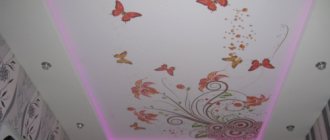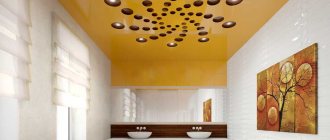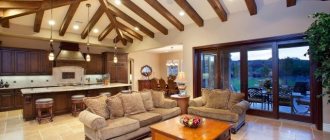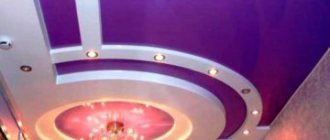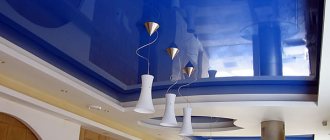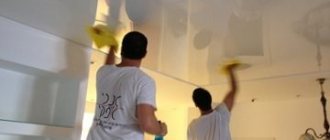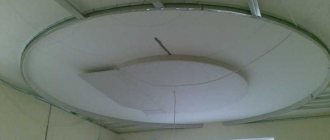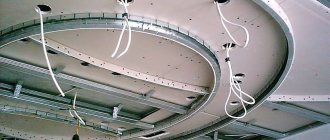Types and composition of materials for suspended ceilings
A stretch ceiling is, in fact, an additional vault under a load-bearing ceiling, designed to remove all the imperfections of the base surface and create an attractive appearance. The structure is a frame fixed around the perimeter of the room, onto which a thin fabric is stretched. The frame is made of aluminum or plastic and does not affect the human body in any way, but the stretched material can.
When installing suspended ceilings, 2 types of canvases are used:
- PVC . This is a thin film of polyvinyl chloride. The main advantages of such a ceiling are water resistance, low cost, a wide range of colors and the ability to decorate using photo printing. Disadvantages: the need to warm up during tension, the difficulty of hiding the seam, and low mechanical strength. PVC film comes in several textures: glossy, matte, satin and translucent.
- Fabric cloth . Made from synthetic fabric. The most common material is woven from polyester fibers (polyester is most often used). To give strength, the canvas is impregnated with a special polyurethane-based product. The advantages of a fabric ceiling are high mechanical strength, cold tension, attractive appearance, and breathable effect. Disadvantages - increased cost compared to PVC, smaller range of colors, tendency to accumulate dust, limited ceiling area.
The choice is made taking into account the purpose of the room, ecology and visual appeal.
Harmfulness determines the chemical composition of the materials used to produce the fabric. Safety depends on what substances are contained in the constituent elements of the ceilings, as well as their quantity and likelihood of release.
The basis of the film web is PVC, the synthesis of which uses chlorine and hydrocarbons of petroleum origin. To ensure elasticity, light resistance and durability, numerous additives are introduced into the polymer. They make up more than half of the total mass of the material; these are stabilizers, plasticizers, biocides, pigments, including metal oxides. Typically, more than 120 ingredients are used.
Fabric sheets are made from polyester materials impregnated with polyurethane. The result is a rubber-like composition that is highly resistant to solvents and elevated temperatures.
How harmful a suspended ceiling is is judged by the presence of dangerous components in the composition of the fabric. The table shows the average values of some substances that can affect human health.
| Ingredient | Safe norm | Fabric cloth | PVC canvas |
| Formaldehyde | 0,01 | 0,001-0.003 | 0,003-0,03 |
| Phenol | 0,003 | no more than 0.002 | 0,002-0,008 |
| Xylene | 0,04 | 0,003-0,006 | 0,001-0.002 |
| Ethyl acetate | 0,1 | 0,006-0,008 | 0,01-0,4 |
| Toluene | 0,6 | less than 0.002 | 0,01-0,6 |
| Acrylonitrile | 0,03 | less than 0.01 | absent |
| Pseudocumene | 0,015 | absent | up to 0.01 |
| Butyl acetate | 0,1 | absent | up to 0.01 |
| Acetone | 0,3 | absent | no more than 0.2 |
The table shows average data on the content of hazardous components in the composition of fabric materials from domestic and foreign manufacturers. However, when purchasing, take into account the risk of purchasing homemade, handicraft products. In them, the specified ingredients significantly exceed the norm.
Choosing suspended ceilings: pros and cons
Leaving aside for now the harm from chemical compounds released from the ceiling fabric, first of all it is necessary to mention the lack of ventilation and moisture exchange between the air of the room and the ceiling material in the case of installing polyvinyl chloride film. Especially when it comes to new buildings, where the process of cement setting in concrete continues in fresh wall panels. Which, although hundreds of times slower compared to the zero production cycle of wall panels, still takes place.
And if the ceiling “does not breathe,” mold may well form on it. Which in the limited space between the main and suspended ceilings can grow quite rapidly. And its smallest spores may well penetrate the fastener structure around the perimeter of the room and cause allergic problems.
Mold passes through the material of suspended ceilings and grows along the walls.
Woven materials have another problem - they are more easily contaminated with dust. Although this problem can be solved by cleaning them regularly.
So, possible “cons” are allergies and dust. The “advantages” include
- speed of installation,
- unsurpassed flatness of planes,
- aesthetics.
How dangerous is PVC film for health?
The question of whether a stretch ceiling with PVC fabric is harmful to health is rightly of concern to many who plan to install it in an apartment. The film always contains toxic substances - formaldehyde, phenol and toluene. Each of them is very dangerous for the respiratory system and eyes if the concentration in the air exceeds the norm. It is important to understand the dangers of polyvinyl chloride.
Under normal conditions in a room, PVC film does not violate environmental safety, since these ingredients are in a bound state and are not able to volatilize.
The toxic effect occurs during ceiling installation. When stretched, the film web must be heated to 70°C, for which special devices are used - heat guns. During this period, the harmfulness increases sharply, as the release of substances hazardous to health begins, which become volatile under the influence of temperature. Their appearance in the air is confirmed by the characteristic smell of phenols, reminiscent of paint. It lasts from 2-3 days to 14-15 days. Staying indoors for a long time at this time is harmful to human health. Complete disappearance of the odor indicates that the problem has been resolved.
Danger to occupants also arises from fire or fire. PVC is a self-extinguishing material, but it can smolder. The process stops the release of chlorine, so there is no open flame, but the gas itself causes serious harm to the respiratory system. During smoldering, acidic (hydrochloric acid) smoke is possible with an increase in the concentration of dioxin, as well as cadmium and other heavy ingredients.
In addition to harmful emissions under special conditions, the performance characteristics of the film material are taken into account. The polymer film does not allow air to pass through and is absolutely vapor-tight. For this reason, the harm of suspended ceilings is complemented by the appearance of a microgreenhouse effect and vapor condensation.
The lack of natural ventilation requires frequent ventilation of the room.
Steam in a room is not only generated in the kitchen or bathroom. It appears even during a person’s normal exhalation. Rising to the ceiling, the steam does not leave the room, but condenses in contact with a cold surface. This leads to increased humidity, mold and mildew, which is harmful for asthmatics and allergy sufferers. This phenomenon is also dangerous for the child.
Damage to PVC ceilings
Considering the harm of suspended ceilings to health, it is worth mentioning their existing varieties. The presented finishing can be made of PVC film or fabric. Each stretch ceiling option has its own characteristics.
PVC film is considered today the most popular material for such finishing. This material is cheaper than fabric. PVC film is easy to care for and can withstand high humidity. Even if the upstairs neighbors forget to turn off the tap, the film will be able to hold a fairly large volume of water without letting it into the room.
However, the presented coating is most often counterfeited by unscrupulous manufacturers. In this case, the process of manufacturing the material is not carried out according to the established technology. There is no need to talk about the quality of such finishing.
Can fabric stretch ceilings be considered safe?
Such fabrics are made from polyester threads, which are actively used in the production of clothing (even underwear). Polyurethane impregnation and elements made from this material are widely used in the footwear industry, which indicates the quality of the fabric. This is an environmentally friendly material that is safe for the human body.
The high environmental friendliness and lack of toxicity of products from well-known manufacturers of textile ceiling fabrics is confirmed by relevant certificates. They have been awarded the status of environmentally friendly products according to the international standard system (ISO).
Immediately after installation there is a smell, but it disappears quickly, you just need to ventilate the room. Thanks to micro-holes in the structure of the material, the textile fabric has a breathable effect, which eliminates problems with condensation and ventilation. On the question of whether fabric stretch ceilings are harmful to health or not, the opinion of doctors is mostly positive - they are quite harmless to humans.
Dust that actively accumulates in the ceiling fabric poses a certain danger. Taking into account the fact that cleaning the ceiling is a problymatic event, certain contraindications for installing fabric sheets exist for allergy sufferers whose bodies are sensitive to dust in the house. But for this category of people, special hyperallergenic fabrics are produced, which are also recommended for installation in medical institutions.
Why stretch ceilings can cause harm
There are many myths around suspended ceilings. Some find benefit in such designs. Others provide evidence of mortal danger to humans. The true picture depends on the materials used. Let's consider the features of different types of ceilings and draw a conclusion about whether it is good or bad to use a tension structure in an apartment.
Chemical hazard
It is associated with the belief that plastics emit harmful substances. Among them, the following are especially common:
- Phenol. A highly toxic component that, even in small quantities, negatively affects people’s well-being. It can affect the cardiovascular system and central nervous system, disrupt the functioning of the kidneys, liver, lungs, and provoke cancer.
- Toluene. A toxic substance that depresses the central nervous system. This causes insomnia, loss of appetite, headaches, impaired concentration, and memory disorders. Toluene is especially dangerous for pregnant women.
- Cadmium. Salts of this heavy metal are used as a pigment. In the human body, they disrupt the functions of the liver, spleen, kidneys, the functioning of the excretory system, and contribute to the development of malignant neoplasms.
- Chlorine. Can seriously impair the functioning of the respiratory system. Cause the following symptoms: dry cough, shortness of breath, rise in body temperature, tachycardia.
Modern polymers from reliable manufacturers undergo multiple testing according to European standards, which eliminates any harm to human health. Even after heat treatment, the level of harmful emissions does not exceed permissible values. The risk disappears completely after 15-20 days. Fabric sheets are more environmentally friendly, since the composition of the material does not contain harmful ingredients. The danger of chemical damage comes from cheap counterfeits, where the specified substances exceed the permissible limit.
Poor ventilation
Any suspended ceiling using polymers changes the air circulation system. The film canvas completely eliminates it, and the fabric partially disrupts it. As a result, air masses stagnate and condensation accumulates.
Such changes are harmful to health and are completely unacceptable in a room where a small child is located. Therefore, it is important to entrust the installation to specialists so that the structure is installed correctly.
Allergy
There are no suspended ceilings that are completely hypoallergenic in their composition. The cause of the reaction may be plastic, additives (most often dyes) or dust accumulation in the fabric. Medical picture: malaise, runny nose, sneezing, increased lacrimation. The most dangerous consequences are suffocation, allergic asthma, swelling of the respiratory tract.
High-quality canvases are considered environmentally friendly. However, harm from suspended ceilings cannot be ruled out. The material must be selected taking into account its quality and the characteristics of the human body.
Harmful substances to human health
To understand why low-quality stretch ceilings are harmful, you can familiarize yourself with the properties of the substances they contain:
- Phenol
. This component is included in the list of prohibited materials in many countries around the world. The reason is its high toxicity. Phenol negatively affects the entire human body: this is reflected in the deterioration of the functions of the cardiovascular and nervous systems, malfunction of the kidneys and liver, inflammation of the nasopharynx and pulmonary edema. The constant presence of the substance in the body ultimately provokes the appearance of cancer cells and infertility diseases. - Cadmium
. After entering a person, this heavy metal gradually accumulates in the kidneys, liver, spleen and bone tissue. In the future, various serious diseases begin to appear because of this. It is cadmium that is the main cause of the formation of stones in the liver and kidneys, which creates serious obstacles to the functioning of the excretory organs. This further contributes to the rapid growth of cancerous tumors. - Toluene
. This volatile component enters the circulatory system by inhaling air. With the blood, toluene spreads throughout the body, poisoning it. The health hazards of low-quality PVC ceilings include sleep disturbances, migraines, feelings of depression, and loss of appetite. A general lack of concentration appears, manifested in a slower reaction, memory deterioration, and dysfunction of the central nervous system. This also affects the decrease in hearing and vision acuity. First of all, toluene is dangerous for pregnant women: as medical studies have shown, with the constant inhalation of toluene vapor by the expectant mother, the risk of developing pathologies in the baby increases significantly. - Chlorine
_ In its normal bound state, this component does not have any harmful effects on the human body. The problem arises in cases where chlorine is present in increased quantities in goods supplied to the market due to the fault of unscrupulous manufacturers. As a result, poisoning may occur with symptoms such as irritation of the mucous membranes, dry hacking cough, breathing problems, and increased temperature. The affected person begins to experience serious problems with cardiac arrhythmia and pain in the chest area. Chlorine is considered a powerful carcinogen that promotes the appearance of cancer.
Chinese stretch ceilings, which are hazardous to health, emit toxins almost constantly. This is indicated by an unpleasant odor, which cannot be eliminated for a long time.
The percentage of emitted harmful substances increases noticeably with increasing temperature in the room where the tension fabric is installed. This is especially dangerous for small rooms such as a bathroom, kitchen or sauna: this imposes a huge responsibility on the choice of high-quality finishing materials.
Doctors' opinion
Doctors of different specializations are quite unanimous in their opinions about stretch ceilings. When using fabric that has a certificate of compliance with international standards, as well as proper installation and operation, the design cannot adversely affect human health.
Doctors do not recommend making a film stretch ceiling in a children's room. This is due to the emergence of a special microclimate in the room, in particular, an increase in temperature and humidity. In addition, the very appearance of such a ceiling is poorly associated with a children's interior, which neutralizes all its advantages.
Doctors advise moving into an apartment 5-7 days after installing the film ceiling, when the smell has completely disappeared. It is recommended to use only designs from trusted manufacturers.
If signs of intoxication of the body appear after installation, it is necessary to urgently ventilate the entire apartment and consult a doctor to determine the causes of the ailment.
If it is confirmed that a bad ceiling has been installed, it is necessary to urgently dismantle it. A long stay in a room with such a design can cause disturbances in the central nervous system and respiratory problems.
What is considered harmful, or international safety standards
First of all, we should not forget that nature has made us all different, with organisms very different from each other. Therefore, there may be an unpredictable reaction to all kinds of substances. Some people feel comfortable and comfortable in a room with artificial decoration, while others may experience an allergy attack. So in our age, when people’s immunity is significantly weakened, it is hardly possible to confidently say that some material is dangerous for absolutely everyone.
However, there are general norms that must be observed. We are talking about ISO international environmental standards. And if everything is in order in this regard, then the health of the apartment owners is not in danger. Therefore, before installing suspended ceilings, first of all, ask to see safety certificates. And not only for the material itself, but also for the execution of the work. And even though the services of a certified installer will cost more than some “left-handed” performers, it is better not to try to experiment on your own health.
What are the health risks of low-quality stretch ceilings?
Only counterfeit products can seriously affect human health. The most dangerous are handicraft film canvases (and not necessarily Chinese ones). Such products contain significantly higher levels of formaldehyde, phenols, toluene, heavy metal salts and other harmful substances.
It is necessary to check the product, first of all, by smell. Counterfeits can be identified by it already upon purchase, but the most accurate assessment is by the intensity and duration of the odor after heat treatment. The discharge is so significant that the technician may feel ill already at the installation stage. If 14-15 days after installation the smell continues to bother the owner, then this is an obvious counterfeit.
Fabric sheets also compare favorably in terms of quality. They are much more difficult to counterfeit, as it is easily determined by their appearance.
How to protect yourself from negative consequences
To protect your health when installing suspended ceilings, it is useful to know about some safety measures:
- Careful selection of goods by manufacturer, excluding counterfeits. Preference should be given to the most trusted companies. The seller should request a certificate of conformity and a certificate of product quality. Excessive savings on cost often cause major health problems.
- Ensuring regular, adequate ventilation of the room where the suspended ceiling is installed.
- Removing or isolating heat sources from the fabric. Heating pipes, chimneys and high-power lighting fixtures can cause damage. You cannot install suspended ceilings in saunas.
The main defense against possible risks is knowledge of why harm to health occurs. Correct installation and subsequent operation will ensure such protection in full. Of course, if a high-quality canvas is installed.
How to choose a safe coating
The safety of a stretch ceiling is guaranteed by some recommendations for its selection.
International standards
The safety of the product is guaranteed if it has a certificate according to ISO 9001. In addition to the general requirements, pay attention to the IMO fire safety certificate and a document confirming antibacterial protection according to the Sanitized standard.
Environmental friendliness of suspended ceilings
The international certificate confirms the complete absence of harmful substances in the composition of the fabric in a volatile state and normalizes their total content. The absence of negative effects is confirmed by a certificate according to Oeko-Tex Standard 100. In addition, modern labeling provides the designation “A+”, indicating the absence of dangerous volatile ingredients.
Which manufacturers can you trust?
According to numerous positive reviews, the following reliable companies stand out:
- BARRISOL and Clipso (France);
- RENOLIT, TM Descor and PONGS (Germany);
- PTCM Polyplast (Belgium).
Original branded products have appropriate markings on the canvas.
Recommendations for selection
Basic recommendations when choosing a stretch ceiling:
- Make sure that a quality product is being sold.
- Check the availability of supporting documents.
- Select the desired product based on color and technical parameters.
- Make sure you are not allergic to the fabric you are purchasing.
- Check for warranty.
- Entrust installation to professionals.
With the right choice of stretch ceiling, the risk of harm to health is reduced to zero. To obtain a full guarantee, an installation contract is concluded with a specialized organization, which will simultaneously confirm the quality of the purchased product.
Safe stretch ceilings for children's rooms
Doctors do not recommend installing suspended ceilings in a children's room. However, this does not mean that they are prohibited from being installed there. Products with an international certificate are harmless. Fabric sheets that are clean immediately after installation are considered the safest. The only condition is good ventilation of the room upon completion of work.
At the same time, we must remember that a suspended ceiling changes the air parameters in the nursery. To prevent it from stagnating, the room must be regularly ventilated or care must be taken in advance to install forced ventilation. In addition, you should constantly monitor the temperature and humidity in the room.
Poor ventilation
When considering the pros and cons for the health of suspended ceilings, one should take into account the fact that PVC films create great difficulties in ventilating the room. The fact is that this material is completely sealed and airtight.
Because of this, the humidity and temperature in the room increases. Under such conditions, harmful compounds contained in polyvinyl chloride are noticeably activated. In order to somehow reduce the percentage of phenol and toluene in the air, it is necessary to modernize the ventilation system. Otherwise, poisoning with toxic components of PVC will most likely occur. This will be expressed in a feeling of lethargy, fatigue, depression, insomnia, suffocation, migraines.

